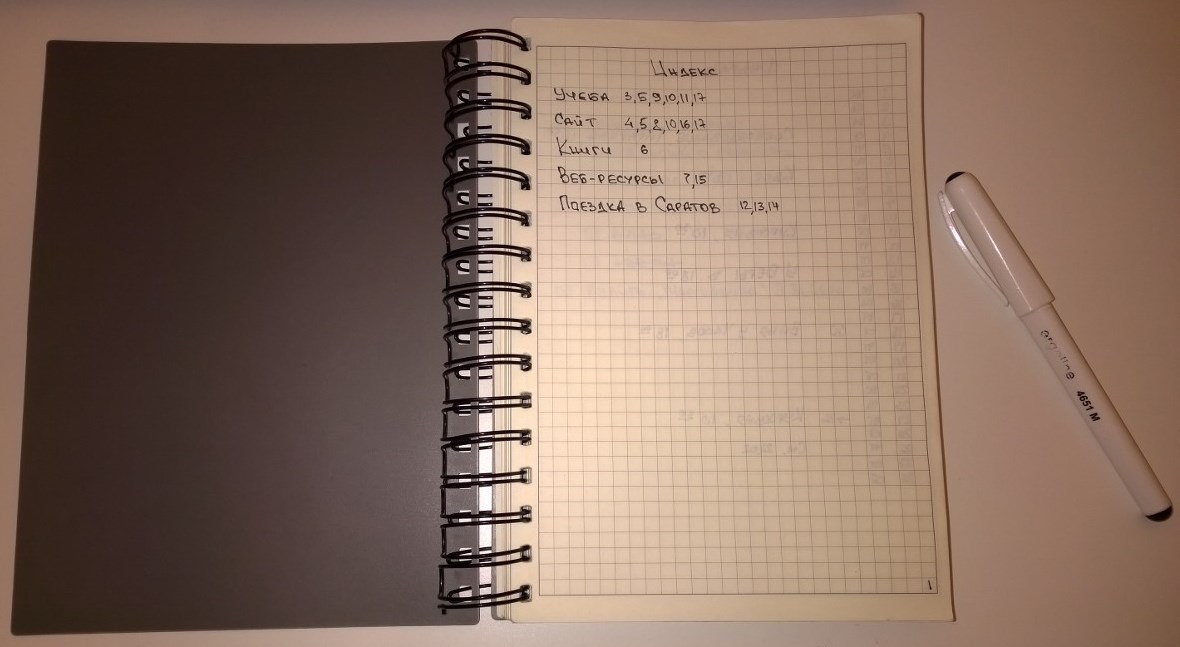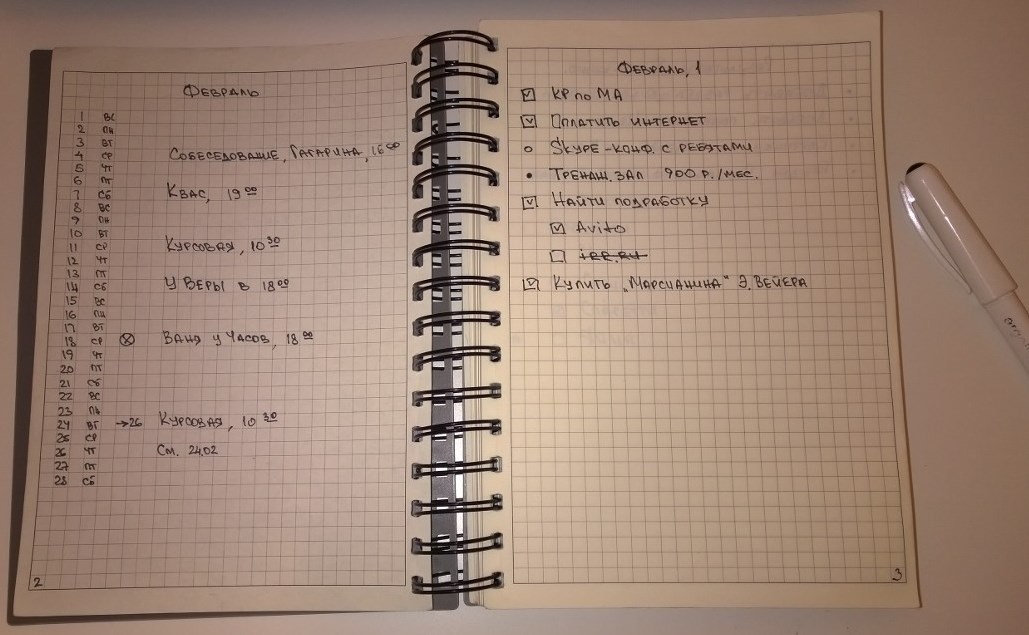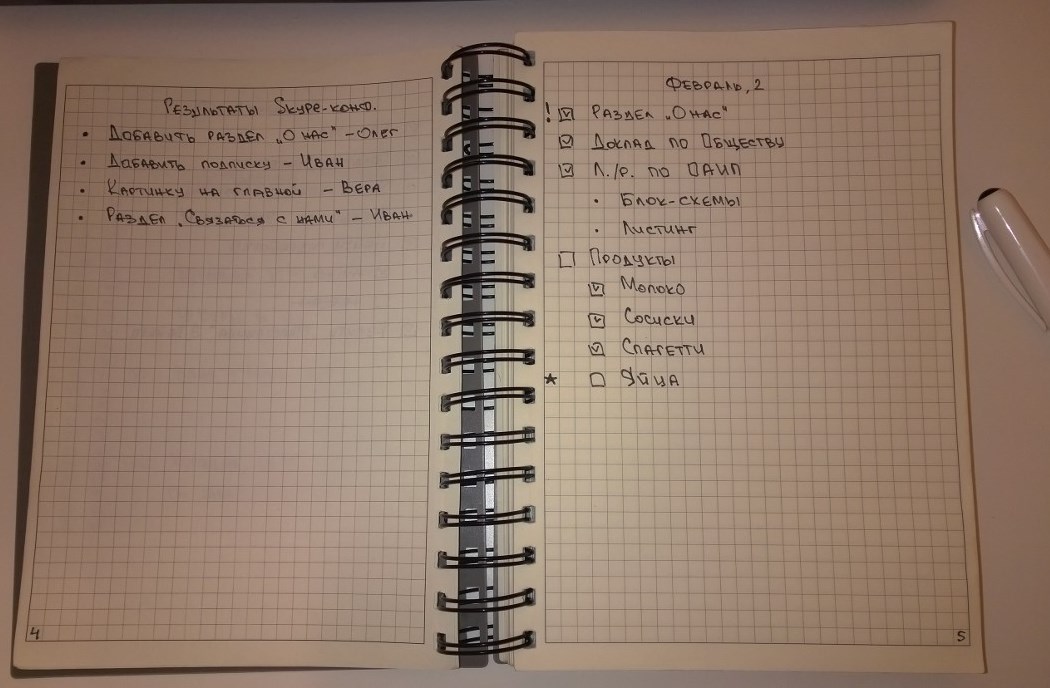About how students and the site are engaged, and now they are not late for lectures
- Where is Vera? - I almost went to the desk so that my whisper could only hear the sitting Daria in the front, she immediately deviated and began to scribble something. I looked around: in addition to us in the audience there was almost the entire stream, the always gloomy teacher, even the local Vaska yawned on the windowsill, basking in the morning sun. Faith was not.
A hand bent behind her back in an unnatural posture, waved in front of me a note folded in three. “She slept. Yesterday, only at 2 I remembered the seminar ”- Vera did not differ in her ability to organize herself, and after the appearance of the site and blog, she was completely lost in time. I took the pen:
“In the evening, we’ll have it all together. I will tell about the Bullet Journal method. Grab the empty notebooks. "
')

The kettle began to whistle, summoning everyone to the kitchen.
- So you want to say that your scribbles in a notebook help you not to be late for a lecture? - Vera poured boiling water while we were seated at the table.
“Yes and no,” I twice dipped the tea bag into the water very artistically and then handed it to Darya. - My notes and their compilation method are a tool. And what to do with the tool? Properly noticed, Wan - the correct use.
From astonishment, Ivan’s head in the laptop monitor started fussing and began to chew faster.
- BUT? What? - and without swallowing he muttered. Vanya has been in another city for a month already, but did not even think about missing our meeting.
- So, I write down every little thing. Who knows what will come in handy later? The idea, task, reminder, meeting, book - all in a notebook. Finish my children, and I will open a completely new world for you - at first I didn’t have a single "n" without a good reason; apparently, this fact allowed me to be considered an expert.
Vanya was conveniently placed on a stack of books, we sat on the floor with a “living” triangle, laid out clean notebooks in front of us, mine was full.
Index

On the first and in the future, the “Index” block is always formed on the right notepad page at the beginning of each month. Index is a table of contents that helps you quickly find the topic you need. The table of contents includes the topic and page numbers on which the topic is covered.
- That is, you first need to number the entire notebook? - Daria roared.
- In the original of the system - yes, but it is more convenient for me to number the page upon filling it out, because Often sheets from a notebook are simply pulled out.
- And what topics? Need to decide in advance? Vangavat? - Vanya, it turns out, also listened, although the head was always looking somewhere sideways.
- At first, it is impossible, because you still do not know what exactly will get into the notebook. But after a couple of months, this block will almost always be filled immediately. So I already have a formed “backbone”, but from time to time something appears and disappears.
The calendar

On the reverse Index page, the “Calendar” block is formed for a month. The calendar is used to record events that probably will not change in the date, such as birthdays, meetings, course submission dates, etc. To form the calendar, you need to record the dates of the month one after another, put days of the week opposite.
- Ahead of the question, Vanya, no, this block is not filled immediately, but within a month, more on that later.
- Even a 100% event can be transferred, pulling out a leaf? - Vera sarcastically asked. The skeptic from it always turns out great. This is both annoying and fruitful when discussing various ideas.
- Great question. In the original, this nuance is not described, perhaps this is due to the mentality of the author and the peculiarities of holding meetings in the west. Unfortunately, or fortunately, everything is different here. And for convenience, I use the following scheme:
1. I leave a certain distance between the day of the week and the description of the event;
2. If the event was canceled, then I put a circle with a cross in the empty area;
3. If it was transferred, then I put the arrow to the right and the number to which the event is being transferred, and then on this day I prescribe a link, for example, “See. 02.2.15.15.
- And if the transfer event occurs next month? - and we were all sad; Daria was talking about scholarships.
- Hmm, in this sad case, you can put a circle with a cross and duplicate the event in the next calendar, and if it is not filled, then I would set myself the task “to form the calendar for the next month and duplicate the event from February 24, 2015” .
Agenda
The "Agenda" block is a list of tasks, notes and events for the day. Most often filled the day before and during the day. Only 3 types of markers:
• Tasks - current affairs, indicated by checkboxes. If the task is completed, tick the checkbox. If the task has lost relevance, it is deleted. You can use subtasks;
• Notes - ideas, observations, indicated by bold dots;
• Events - upcoming meetings and events are indicated by “empty” circles. An important event is duplicated in the block "Calendar".
You can also use notes. Notes are margins. Help to understand the essence of the record ("Priority", "Explore", "Site", etc.):
- Wait, wait, wait. Those. if tomorrow night we need to meet, then I will make an entry “Meeting the Company” with the marker “Event” on the agenda of tomorrow, ”began Daria. - If I have to prepare a report for tomorrow's seminar, I will make an entry “Report on blablabla” with a marker “Task”, and if tomorrow I find out that the teacher went to “sick leave” for two weeks, then this moment will fall into a notebook, but already with a marker "note". So? Isn't it a waste of time?
- At first it seemed to me that filling out the notebook was a waste of time, but after a couple of weeks I began to notice that I had more time in a day. If I forget something, it is enough for me to look in a notebook. If an idea has arisen in my head, I will write it down in a notebook and - what is important - I will return then to thinking it over. There are always current task statuses in notepad. Carrying out the next task, I get pleasure from putting down “daws” - this motivates. At the end of the day, the fulfilled agenda charges with a positive and correct attitude. And I have never been late for a lecture, I didn’t intend, but I still looked in the direction of Vera, who had already managed to look away.
- Did you say something about various topics in the table of contents? - Ivan looked strictly at us, apparently, now we were in priority.
Collections

Collections are subject lists. They help to “fill” the monthly calendar and the agenda (for example, “List of books to read”, “Web resources”, etc.).
In the original, several pages are allocated for the “Collection” blocks after the “Calendar” and before the “Agenda”. But in my case “Agenda” and “Collections” are mixed together, because I find it hard to guess how many pages need to be laid.
The subject of “Collection” is indicated in the “Index” block by the name and page if the topic is new; only a page if the topic has already been met this month.
- It is clear, i.e. when you are bored at a lecture, you open the Index, find the Timekiller theme, slide your finger to the page number, open it and, voila, a list with interesting web resources in front of you, Vanya concluded with an example. The head was again distracted and stared somewhere sideways.
“Well, sort of,” I almost agreed. - Ver, be on your list yesterday the item “Prepare for the seminar” ...
- ... we would not have gathered today! - Vera looked at my reaction, smiled and proceeded to fill in the notebook.
Instead of conclusion
A couple of weeks later, Vanya returned and corrected the newsletter in the blog ;
Daria learned to pass on notes more gracefully;
Vera, a couple of weeks after the first notepad recording, no longer received the “n”.
In short,
1. Create the “Index” page (right page) - this is the first page in the notebook; Table of Contents includes topics and page numbers;
2. Create a “Calendar” for the month (left page): the name of the month, numbers and letters denoting the days of the week. On the contrary, we indicate birthdays and dates of other events, which certainly will not change;
3. We form the "Agenda" (for one or several days). We use markers "Tasks", "Notes", "Events". Be sure to number the pages, enter the data in the index;
4. If necessary, add notes to each task or event;
5. We make up “Collections”, the topic is indicated in the “Index”;
6. At the end of the month we move all current tasks to the new “Calendar”.
Previous story:
The story of how students overnight the site gash
A hand bent behind her back in an unnatural posture, waved in front of me a note folded in three. “She slept. Yesterday, only at 2 I remembered the seminar ”- Vera did not differ in her ability to organize herself, and after the appearance of the site and blog, she was completely lost in time. I took the pen:
“In the evening, we’ll have it all together. I will tell about the Bullet Journal method. Grab the empty notebooks. "
')

The kettle began to whistle, summoning everyone to the kitchen.
- So you want to say that your scribbles in a notebook help you not to be late for a lecture? - Vera poured boiling water while we were seated at the table.
“Yes and no,” I twice dipped the tea bag into the water very artistically and then handed it to Darya. - My notes and their compilation method are a tool. And what to do with the tool? Properly noticed, Wan - the correct use.
From astonishment, Ivan’s head in the laptop monitor started fussing and began to chew faster.
- BUT? What? - and without swallowing he muttered. Vanya has been in another city for a month already, but did not even think about missing our meeting.
- So, I write down every little thing. Who knows what will come in handy later? The idea, task, reminder, meeting, book - all in a notebook. Finish my children, and I will open a completely new world for you - at first I didn’t have a single "n" without a good reason; apparently, this fact allowed me to be considered an expert.
Vanya was conveniently placed on a stack of books, we sat on the floor with a “living” triangle, laid out clean notebooks in front of us, mine was full.
Index

On the first and in the future, the “Index” block is always formed on the right notepad page at the beginning of each month. Index is a table of contents that helps you quickly find the topic you need. The table of contents includes the topic and page numbers on which the topic is covered.
- That is, you first need to number the entire notebook? - Daria roared.
- In the original of the system - yes, but it is more convenient for me to number the page upon filling it out, because Often sheets from a notebook are simply pulled out.
- And what topics? Need to decide in advance? Vangavat? - Vanya, it turns out, also listened, although the head was always looking somewhere sideways.
- At first, it is impossible, because you still do not know what exactly will get into the notebook. But after a couple of months, this block will almost always be filled immediately. So I already have a formed “backbone”, but from time to time something appears and disappears.
The calendar

On the reverse Index page, the “Calendar” block is formed for a month. The calendar is used to record events that probably will not change in the date, such as birthdays, meetings, course submission dates, etc. To form the calendar, you need to record the dates of the month one after another, put days of the week opposite.
- Ahead of the question, Vanya, no, this block is not filled immediately, but within a month, more on that later.
- Even a 100% event can be transferred, pulling out a leaf? - Vera sarcastically asked. The skeptic from it always turns out great. This is both annoying and fruitful when discussing various ideas.
- Great question. In the original, this nuance is not described, perhaps this is due to the mentality of the author and the peculiarities of holding meetings in the west. Unfortunately, or fortunately, everything is different here. And for convenience, I use the following scheme:
1. I leave a certain distance between the day of the week and the description of the event;
2. If the event was canceled, then I put a circle with a cross in the empty area;
3. If it was transferred, then I put the arrow to the right and the number to which the event is being transferred, and then on this day I prescribe a link, for example, “See. 02.2.15.15.
- And if the transfer event occurs next month? - and we were all sad; Daria was talking about scholarships.
- Hmm, in this sad case, you can put a circle with a cross and duplicate the event in the next calendar, and if it is not filled, then I would set myself the task “to form the calendar for the next month and duplicate the event from February 24, 2015” .
Agenda
The "Agenda" block is a list of tasks, notes and events for the day. Most often filled the day before and during the day. Only 3 types of markers:
• Tasks - current affairs, indicated by checkboxes. If the task is completed, tick the checkbox. If the task has lost relevance, it is deleted. You can use subtasks;
• Notes - ideas, observations, indicated by bold dots;
• Events - upcoming meetings and events are indicated by “empty” circles. An important event is duplicated in the block "Calendar".
You can also use notes. Notes are margins. Help to understand the essence of the record ("Priority", "Explore", "Site", etc.):
- Wait, wait, wait. Those. if tomorrow night we need to meet, then I will make an entry “Meeting the Company” with the marker “Event” on the agenda of tomorrow, ”began Daria. - If I have to prepare a report for tomorrow's seminar, I will make an entry “Report on blablabla” with a marker “Task”, and if tomorrow I find out that the teacher went to “sick leave” for two weeks, then this moment will fall into a notebook, but already with a marker "note". So? Isn't it a waste of time?
- At first it seemed to me that filling out the notebook was a waste of time, but after a couple of weeks I began to notice that I had more time in a day. If I forget something, it is enough for me to look in a notebook. If an idea has arisen in my head, I will write it down in a notebook and - what is important - I will return then to thinking it over. There are always current task statuses in notepad. Carrying out the next task, I get pleasure from putting down “daws” - this motivates. At the end of the day, the fulfilled agenda charges with a positive and correct attitude. And I have never been late for a lecture, I didn’t intend, but I still looked in the direction of Vera, who had already managed to look away.
- Did you say something about various topics in the table of contents? - Ivan looked strictly at us, apparently, now we were in priority.
Collections

Collections are subject lists. They help to “fill” the monthly calendar and the agenda (for example, “List of books to read”, “Web resources”, etc.).
In the original, several pages are allocated for the “Collection” blocks after the “Calendar” and before the “Agenda”. But in my case “Agenda” and “Collections” are mixed together, because I find it hard to guess how many pages need to be laid.
The subject of “Collection” is indicated in the “Index” block by the name and page if the topic is new; only a page if the topic has already been met this month.
- It is clear, i.e. when you are bored at a lecture, you open the Index, find the Timekiller theme, slide your finger to the page number, open it and, voila, a list with interesting web resources in front of you, Vanya concluded with an example. The head was again distracted and stared somewhere sideways.
“Well, sort of,” I almost agreed. - Ver, be on your list yesterday the item “Prepare for the seminar” ...
- ... we would not have gathered today! - Vera looked at my reaction, smiled and proceeded to fill in the notebook.
Instead of conclusion
A couple of weeks later, Vanya returned and corrected the newsletter in the blog ;
Daria learned to pass on notes more gracefully;
Vera, a couple of weeks after the first notepad recording, no longer received the “n”.
In short,
1. Create the “Index” page (right page) - this is the first page in the notebook; Table of Contents includes topics and page numbers;
2. Create a “Calendar” for the month (left page): the name of the month, numbers and letters denoting the days of the week. On the contrary, we indicate birthdays and dates of other events, which certainly will not change;
3. We form the "Agenda" (for one or several days). We use markers "Tasks", "Notes", "Events". Be sure to number the pages, enter the data in the index;
4. If necessary, add notes to each task or event;
5. We make up “Collections”, the topic is indicated in the “Index”;
6. At the end of the month we move all current tasks to the new “Calendar”.
Previous story:
The story of how students overnight the site gash
Source: https://habr.com/ru/post/289382/
All Articles